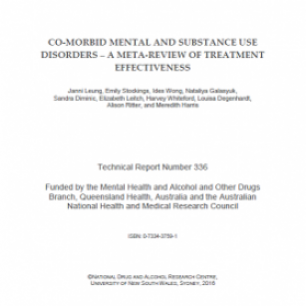Comorbidity of mental and substance use disorders is common, debilitating and associated with poor clinical and functional outcomes. Data from the Australian National Survey of Mental Health and Wellbeing (NSMHWB) showed that 25.4% of people with a 12-month mental or substance use disorder had a comorbid diagnosis (Slade, Teesson, & Burgess, 2009). Mental and substance use disorders accounted for 183.9 million disability-adjusted life years (DALYs), or 7.4% of all DALYs worldwide in 2010 (Whiteford et al., 2013). Comorbidity magnifies the already heavy burden experienced by people with either a mental health or substance use disorder in isolation. Experimental trials consistently demonstrate that this population experience greater symptom severity, poly-drug use, increased risk of violence, increased suicidal ideation and a greater number of previous suicide attempts (Barrett, Mills, & Teesson, 2011; Davis et al., 2006; Erfan, Hashim, Shaheen, & Sabry, 2010). Individuals with comorbid mental and substance use disorders are more likely to experience poorer short- and long-term outcomes for their mental health and substance use (Burns, Teesson, & O'Neill, 2005; Teesson et al., 2015b; Torrens, Fonseca, Mateu, & Farré, 2005), more severe levels of impairment (Kessler, Chiu, Demler, & Walters, 2005; Slade et al., 2009), and greater use health of services than those with no comorbidity (Slade et al., 2009).
Treatment models for persons with a comorbid mental health and substance use disorder are typically classified into ‘integrated services’ whereby treatments for mental health and substance use problems are provided at the same service; and ‘non-integrated’, whereby treatments are provided in parallel or sequentially at separate services, or treatments are provided to target the more severe disorder initially. In order to plan treatment services for people with comorbid substance use and mental disorders, policy makers need to know which interventions should be delivered for this population based on contemporary evidence of treatment effectiveness.
A number of systematic reviews have summarised the effectiveness of various treatments for people with comorbid mental and substance use disorders. This systematic meta-review aimed to collate and summarise the evidence from these existing reviews on specialised treatments for people with comorbid substance use and mental disorder, by: 1) providing a synthesis of evidence on the effectiveness of different types of specialist treatments in reducing substance use and improving mental health for people with comorbid substance use and mental disorders; 2) evaluating the methods of existing literature to identify limitations in current research and areas in need of future research, and ; 3) creating a database of empirical literature sources stratified by disorder and treatment types, which researchers, clinicians, and policy makers can draw upon to guide clinical practice and service system resource allocation.


